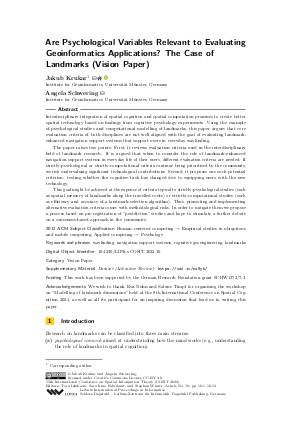LIPIcs.COSIT.2022.10.pdf
- Filesize: 0.75 MB
- 13 pages

 Creative Commons Attribution 4.0 International license
Creative Commons Attribution 4.0 International license

Interdisciplinary integration of spatial cognition and spatial computation promises to create better spatial technology based on findings from cognitive psychology experiments. Using the example of psychological studies and computational modelling of landmarks, this paper argues that core evaluation criteria of both disciplines are not well aligned with the goal of evaluating landmark-enhanced navigation support systems that support users in everyday wayfinding. The paper raises two points. First, it reviews evaluation criteria used in the interdisciplinary field of landmark research. It is argued that when to consider the role of landmark-enhanced navigation support systems in everyday life of their users, different evaluation criteria are needed. If strictly-psychological or strictly-computational criteria continue being prioritised by the community, we risk undervaluing significant technological contributions. Second, it proposes one such potential criterion: testing whether the cognitive task has changed due to equipping users with the new technology. This goal might be achieved at the expense of criteria typical to strictly-psychological studies (such as spatial memory of landmarks along the travelled route) or strictly-computational studies (such as efficiency and accuracy of a landmark-selection algorithm). Thus, promoting and implementing alternative evaluation criteria comes with methodological risks. In order to mitigate them we propose a process based on pre-registration of "postdiction" studies and hope to stimulate a further debate on a consensus-based approach in the community.





Feedback for Dagstuhl Publishing